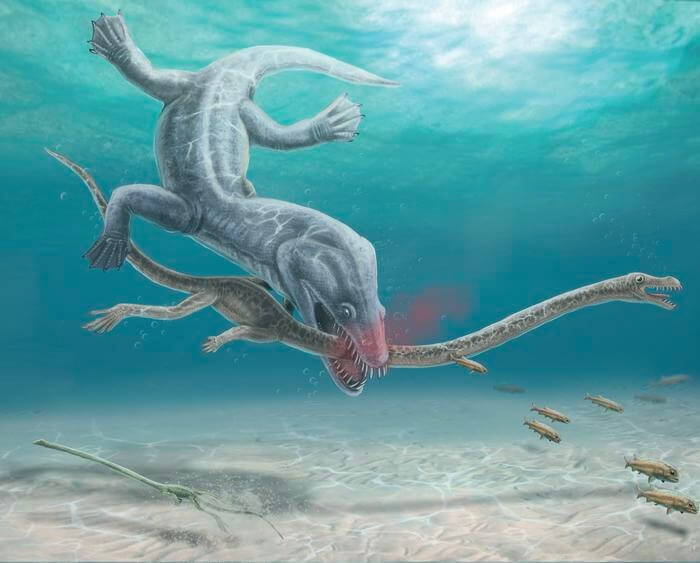In the era of dinosaurs, certain marine reptiles possessed remarkably long necks compared to modern reptiles. While this adaptation was evidently advantageous, scientists have long suspected that their elongated necks made them vulnerable to predators. Now, after nearly two centuries of ongoing research, direct fossil evidence has finally confirmed this hypothesis in a striking and graphic manner.
Researchers, in a study published in the journal Current Biology on June 19, examined the unique necks of two Triassic species of Tanystropheus. These reptiles, distantly related to crocodiles, birds, and dinosaurs, had necks comprised of 13 extraordinarily elongated vertebrae and strut-like ribs. It is believed that these marine reptiles possessed stiffened necks and employed an ambush strategy to catch their prey. However, it appears that the predators of Tanystropheus also exploited their long necks for their own advantage.
Close examination of fossilized bones now reveals clear bite marks on the necks of two specimens representing different species. In one case, the bite marks are located precisely where the neck was broken. According to the researchers, these findings provide gruesome and exceedingly rare evidence of predator-prey interactions in the fossil record dating back over 240 million years.
Stephan Spiekman of the Staatliches Museum für Naturkunde Stuttgart, Germany, remarked, “Paleontologists speculated that these long necks formed an obvious weak spot for predation, as was already vividly depicted almost 200 years ago in a famous painting by Henry de la Beche from 1830. Nevertheless, there was no evidence of decapitation—or any other sort of attack targeting the neck—known from the abundant fossil record of long-necked marine reptiles until our present study on these two specimens of Tanystropheus.”
Spiekman, who conducted this research during his doctoral work at the Paleontological Museum of the University of Zurich, Switzerland, recognized that two species of Tanystropheus coexisted in the same environment. One species, measuring about a meter and a half in length, likely fed on soft-shelled animals such as shrimp, while the much larger species, reaching up to six meters in length, preyed on fish and squid. The shape of the skull provided clear evidence that Tanystropheus spent most of its time in the water.
It was widely known that two specimens of these species had well-preserved heads and necks that ended abruptly. Although it had been speculated that their necks were bitten off, no detailed study had been conducted on the matter. For the new study, Spiekman collaborated with Eudald Mujal of the Stuttgart Museum and a research associate at the Institut Català de Paleontologia Miquel Crusafont, Spain, who specializes in fossil preservation and predatory interactions based on bite traces on bones. After carefully examining the two specimens in Zurich, they concluded that the necks had indeed been bitten off.
Mujal explained, “Something that caught our attention is that the skull and portion of the neck preserved are undisturbed, only showing some disarticulation due to the typical decay of a carcass in a quiet environment. Only the neck and head are preserved; there is no evidence whatsoever of the rest of the animals. The necks end abruptly, indicating they were completely severed by another animal during a particularly violent event, as the presence of tooth traces evinces.”
He continued, “The fact that the head and neck are so undisturbed suggests that when they reached the place of their final burial, the bones were still covered by soft tissues like muscle and skin. They were clearly not fed on by the predator. Although this is speculative, it would make sense that the predators were less interested in the skinny neck and small head and instead focused on
the much meatier parts of the body. Taken together, these factors make it most likely that both individuals were decapitated during the hunt and not scavenged, although scavenging can never be fully excluded in fossils that are this old.”
Spiekman highlighted the intriguing similarity in the scenario surrounding the two specimens, which represent different Tanystropheus species. He stated, “Interestingly, the same scenario—although certainly executed by different predators—played out for both specimens, which remember, represent individuals of two different Tanystropheus species, which are very different in size and possibly lifestyle.”
The findings support previous interpretations that the elongated necks of these ancient reptiles represented a completely unique evolutionary structure that was narrower and stiffer than those of long-necked plesiosaurs. The researchers also note that evolving a long neck as a sea reptile came with potential disadvantages. However, elongated necks clearly served as a highly successful evolutionary strategy, observed in various marine reptiles over a span of 175 million years.
“In a very broad sense, our research once again shows that evolution is a game of trade-offs,” said Spiekman. “The advantage of having a long neck clearly outweighed the risk of being targeted by a predator for a very long time. Even Tanystropheus itself was quite successful in evolutionary terms, living for at least 10 million years and occurring in what is now Europe, the Middle East, China, North America, and possibly South America.”


